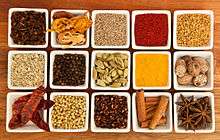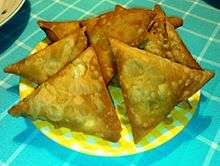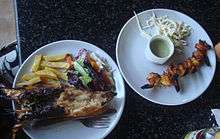Goan cuisine
 |
| This article is part of the series |
| Indian cuisine |
|---|
|
Regional cuisines
|
|
Ingredients, types of food |
|
See also
|
|
Goan cuisine consists of regional foods popular in Goa, an Indian state located along India's west coast on the shore of the Arabian Sea. Rice, seafood, coconut, vegetables, meat, pork and local spices are some of the main ingredients in Goan cuisine. The area is located in a tropical climate, which means that spices and flavors are intense. Use of kokum is another distinct feature. Goan food is considered incomplete without fish. It is similar to Malvani or Konkani cuisine.
The cuisine of Goa is influenced by its Hindu origins, the four hundred years of Portuguese colonialisation and the Muslim rule that preceded the Portuguese.[1] Many Catholic dishes are either similar to or variants of their Portuguese counterparts in both naming or their use of ingredients.
Seafood
The cuisine is mostly seafood-based; the staple foods are rice and fish. Kingfish (vison or visvan) is the most common delicacy. Other seafood delicacies include pomfret, shark, tuna, and mackerel. Among the shellfish are crabs, prawns, tiger prawns, lobster, squid, and mussels. The food of Goan Christians is heavily influenced by the Portuguese.
Introduction of new edibles to Goan cuisine
The Portuguese introduced potatoes, tomatoes, pineapples, guavas, and cashews from Brazil to Goa and consequently India. The chili pepper is the most important aspect of Goan cuisine, which was introduced by the Portuguese and became immensely popular as a very important spice for wider India cuisine. None of these above-mentioned ingredients were used in Goan cuisine before the advent of the Portuguese. The Portuguese also introduced beef and pork to the converts of Catholicism, which were and still are considered a taboo by some of the Hindus of Goa.[2] However it is common to see people of either faith enjoy delicacies of the other.
Hindu cuisine
Hindu cuisine in Goa is mainly pescetarian and lacto-vegetarian, but lately the younger generation have taken up a taste for meat, which was not common before. Hindu cuisine mainly uses less heat, tamarind and kokum for souring, and jaggery for sweetening. It uses asafoetida, fenugreek, curry leaves, mustard, and urad dal.[2] It is not very spicy; less onion and garlic are used. It also includes more vegetables, such as lentils, pumpkins, gourds, bamboo shoots, roots, etc. It is less oily and the medium of cooking is coconut oil.[2]
Popular Goan Hindu dishes include:
- Humann (हूमण) – Fish curry and rice (शीत or भात), also known as kadi or ambot
- Fried fish (तळील्ले नूस्ते)
- Fish suke or dhabdhabit (सुकें) – Dry spicy preparation of fish, eaten as a side dish
- Fish udid methi or uddamethi (उद्दमेथी) – Type of curry consisting of fenugreek and mackerel; a vegetarian version of this dish is also prepared using hog plums (or anything sour and tangy, such as pieces of raw mango)
- Kismur (किस्मुर) – A type of side dish normally consisting of dried fish (mostly mackerel or shrimp), onions, and coconut
- Dangar – Goan fish cutlets (डांगर)
- Kalputi – A dish normally prepared from the head of a large fish, with onions and coconut
- Bhaaji or shak – A generic term for stews, Curries, stir frys made from different vegetables and fruits (भाजी or शाक)
- Bhaji - Fried Fritters with Besan batter. Different kind of bhajis can be made by changing the vegetable used with Besan. Popular bhajis include those containing onion or chilies.
- Khatkhate (ख़तखतें)
- Varan - A lentil preparation often made with coconut milk tempered with mustard, hing, curry leaves, and chilies, served as an accompaniment to rice for the Naivedya, prepared during all Hindu festivals, and an integral part of wedding feasts.
- Tondak – A dish made with beans, cashews, etc. (तोंडाक)
- Different varieties of sweets made from rice and lentils, such as payasu, patoli, madgane, kheer, etc. (गोड्शें)
- Different varieties of pickles and papads (लोणचे or पापड)
- Solachi kadi – A spicy coconut and kokum curry (कडी)
Catholic cuisine


Catholic cuisine in Goa is a fusion of Indian and Portuguese cooking styles. Vinegar (made from the toddy of local coconut trees) is used to give the zingy taste to the meat dishes.
Popular Goan Catholic dishes include:
- Ambot tik – A spicy and sour curry prepared with fish
- Arroz doce – A Portuguese derivative of kheer (sweetened rice custard)
- Balchão – A curry made with prawns/shrimp
- Canja de galinha – A type of chicken broth served with rice and chicken, which is originally a Goan recipe
- Chamuça – A Goan/Portuguese derivative of the samosa
- Chouriço – A spicy pork sausage
- Croquettes – Breaded and fried shredded beef rolls, a common snack among Goan Christians and the Portuguese
- Cafreal – A masala marinate mostly used for chicken or fish made from coriander leaves, green chilies, and other spices.
- Feijoada – A stew brought by the Portuguese. It is made with meat (beef or pork), beans, and cabbage.
- Roast beef and beef tongue – Popular entrees at Goan celebrations
- Sorpotel – A very spicy pork dish eaten with sannas or pão (Goan bread – spelled the same way as in Portugal)
- Xacuti – Type of curry made with roasted grated coconut and pieces of chicken or lamb
- Samarein chi kodi – Goan curry made with fresh and dried prawns
- Patoleo or patoli – A dish of turmeric leaves stuffed with rice, dal, jaggery, and coconut
- Sanna – A dry rice cake; a variant of idli
- Solantule kodi – A spicy coconut and kokum curry
- Vindaloo – A spicy curry made with pork, chicken, or lamb. The name is derived from the Portuguese term for a garlic and wine (vinho e alho or vinha d'alhos) marinade; this dish is popular in the West, particularly the United Kingdom, the United States, Australia, and New Zealand; not related to aloo (potato)[3]
- Bebik – A pudding traditionally eaten at Christmas
- Ros omelette – An omelette drowned in spicy chicken or chickpea gravy and served with pão (Portuguese-Goan bread)
Cashew laddus, nevryo, khaje, revdyo, peda, puran poli, sakhar bhat, madgane, and payasa are other well-known dishes. There are several types of halwa, such as dali kapa (halwa made from red gram), cashew halwa, mango halwa, banana halwa, pumpkin halwa, and dodol.
See also
References
- ↑ "Goa and its cuisine". The Times Of India. 3 April 2008.
- 1 2 3 Chapman, Pat (2009). India: Food & Cooking: The Ultimate Book on Indian Cuisine. New Holland Publishers. p. 256. ISBN 9781845376192.
- ↑ http://cricket.expressindia.com/old//fulliestory.php?content_id=74035
External links
-
 Media related to Cuisine of Goa at Wikimedia Commons
Media related to Cuisine of Goa at Wikimedia Commons

